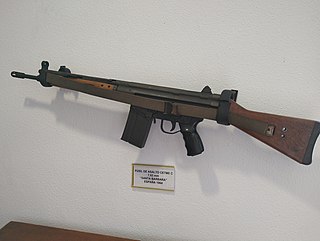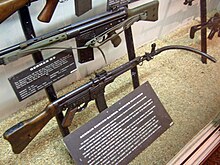
A carbine is a long gun that has a barrel shortened from its original length. Most modern carbines are rifles that are compact versions of a longer rifle or are rifles chambered for less powerful cartridges.

A submachine gun (SMG) is a magazine-fed, automatic carbine designed to fire handgun cartridges. The term "submachine gun" was coined by John T. Thompson, the inventor of the Thompson submachine gun, to describe its design concept as an automatic firearm with notably less firepower than a machine gun. As a machine gun must fire rifle cartridges to be classified as such, submachine guns are not considered machine guns.

The SA80 is a British family of 5.56×45mm NATO service weapons used by the British Army. The L85 Rifle variant has been the standard issue service rifle of the British Armed Forces since 1987, replacing the L1A1 Self-Loading Rifle. The first prototypes were created in 1976, with production of the A1 variant starting in 1985 and ending in 1994. The A2 variant came to be as the result of a significant upgrade in the early 2000s by Heckler & Koch and remains in service as of 2020. The A3 variant was first issued in 2018 with several new improvements.

A recoilless rifle, recoilless launcher or recoilless gun, sometimes abbreviated "RR" or "RCL" is a type of lightweight artillery system or man-portable launcher that is designed to eject some form of countermass such as propellant gas from the rear of the weapon at the moment of firing, creating forward thrust that counteracts most of the weapon's recoil. This allows for the elimination of much of the heavy and bulky recoil-counteracting equipment of a conventional cannon as well as a thinner-walled barrel, and thus the launch of a relatively large projectile from a platform that would not be capable of handling the weight or recoil of a conventional gun of the same size. Technically, only devices that use spin-stabilized projectiles fired from a rifled barrel are recoilless rifles, while smoothbore variants are recoilless guns. This distinction is often lost, and both are often called recoilless rifles.

The StG 44 is a German assault rifle developed during World War II by Hugo Schmeisser. It is also known by its early designations as the MP 43 and MP 44. The StG 44 was an improvement of an earlier design, the Maschinenkarabiner 42(H).

A grenade launcher is a weapon that fires a specially-designed large-caliber projectile, often with an explosive, smoke or gas warhead. Today, the term generally refers to a class of dedicated firearms firing unitary grenade cartridges. The most common type are man-portable, shoulder-fired weapons issued to individuals, although larger crew-served launchers are issued at higher levels of organisation by military forces.

An anti-tank rifle is an anti-materiel rifle designed to penetrate the armor of armored fighting vehicles, most commonly tanks, armored personnel carriers, and infantry fighting vehicles. The term is usually used for weapons that can be carried and used by one person, but is sometimes used for larger weapons. The usefulness of rifles for this purpose ran from the introduction of tanks in World War I until the Korean War. While medium and heavy tank armor became too thick to be penetrated by rigid projectiles from rifles that could be carried by a single soldier, anti-tank rifles continued to be used against other "soft" targets, though recoilless rifles and rocket-propelled grenades such as the bazooka were also introduced for infantry close-layer defense against tanks.

A smoothbore weapon is one that has a barrel without rifling. Smoothbores range from handheld firearms to powerful tank guns and large artillery mortars.
A rifle grenade is a grenade that uses a rifle-based launcher to permit a longer effective range than would be possible if the grenade were thrown by hand.
The Suomi KP/-31 is a submachine gun (SMG) of Finnish design that was mainly used during World War II. It is a descendant of the M-22 prototype and the KP/-26 production model, which was revealed to the public in 1925. It entered service in Finland in 1931, and remained in use until the 1980s.

The Gyrojet is a family of unique firearms developed in the 1960s named for the method of gyroscopically stabilizing its projectiles. Rather than inert bullets, Gyrojets fire small rockets called Microjets which have little recoil and do not require a heavy barrel or chamber to resist the pressure of the combustion gases. Velocity on leaving the tube was very low, but increased to around 1,250 feet per second (380 m/s) at 30 feet (9.1 m). The result is a very lightweight and transportable weapon.
The Ak 5 or Automatkarbin 5 is the Swedish version of the FN FNC assault rifle with certain modifications, mostly to adapt the weapon to the partially subarctic Swedish climate. The Ak 5 is the service rifle of the Swedish Armed Forces. The Ak 5 replaced the Ak 4 in Swedish service. Later versions also accept the Colt M203 grenade launcher attachment. The current standard issue version is the Ak 5C.

The PPSh-41 is a Soviet submachine gun designed by Georgy Shpagin as a cheaper and simplified alternative to the PPD-40. A common Russian nickname for the weapon is "papasha" (папа́ша), meaning "daddy", and it was sometimes called the "burp gun" because of its high fire-rate.

The QSZ-92 is a semi-automatic pistol designed by Norinco.

CornerShot is a weapon accessory invented by Lt. Col. Amos Golan of the Israeli Defense Forces in cooperation with American investors. It was designed in the early 2000s for use by SWAT teams and special forces in hostile situations usually involving terrorists and hostages. Its purpose is similar to that of the periscope rifle; it allows its operator to both see and attack an armed target, without exposing the operator to counterattack.
The evolution of German military rifles is a history of common and diverse paths followed by the separate German states, until the mid-19th century when Prussia emerged as the dominant state within Germany and the nation was unified. This article discusses rifled shoulder arms developed in or for the military of the states that later became Germany; it excludes firearms of the Austrian Empire, except where they were used substantially by German troops.

The ZBD-04 or Type 04 is a Chinese infantry fighting vehicle. It bears some external resemblance to the BMP-3, particularly with regards to its turret and main armament; However, the chassis and internal subsystem possesses a different layout. The earliest prototypes received the designation ZBD-97. An improved version, ZBD-04A, is the vehicle currently in service and being produced.

The CETME Model 58 is a stamped-steel, select-fire battle rifle produced by the Spanish armaments manufacturer Centro de Estudios Técnicos de Materiales Especiales (CETME). The Model 58 used a 20-round box magazine and was chambered for the 7.62×51mm NATO round. The CETME 58 would become the foundation of the widely deployed German Heckler & Koch G3 battle rifle. Semi-automatic variants were also produced for the civilian market.

The PPS is a family of Soviet submachine guns chambered in 7.62×25mm Tokarev, developed by Alexei Sudayev as a low-cost personal defense weapon for reconnaissance units, vehicle crews and support service personnel.

The 7.92×33mm Kurz is a rimless bottlenecked intermediate rifle cartridge developed in Nazi Germany prior to and during World War II, specifically intended for development of the Sturmgewehr 44. The ammunition is also referred to as 7.9mm Kurz, 7.9 Kurz, 7.9mmK, or 8×33 Polte. The round was developed as a compromise between the longer 7.92×57mm full-power rifle cartridge and the 9×19mm Parabellum pistol cartridge, and is the first mass-used intermediate cartridge in the world.

















